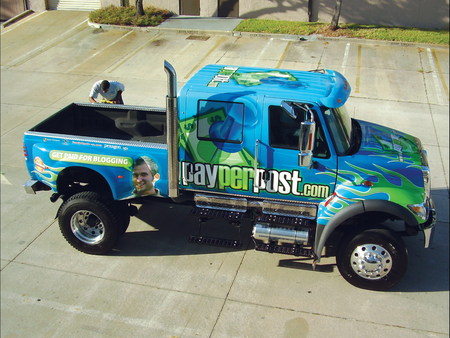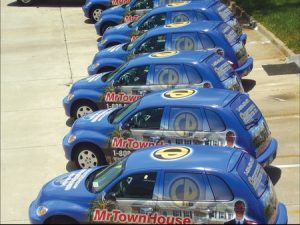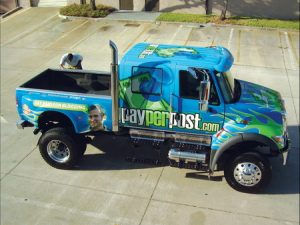Dale Salamacha, president of Media1 Identity Solutions (Longwood, FL), has witnessed vehicle graphics’ recent evolution. The company began wrapping vehicles 10 years ago after having purchased a 24-in. Durachrome thermal-transfer printer. Two years later, it upgraded to a 48-in., thermal machine, and, in 2002, Media1 purchased its first solvent printer. Today, the company operates two, 64-in., Mutoh Toucan solvent printers and employs 23 design and production staffers.
The company wraps 10 to 15 vehicles per week – approximately half of those vehicles receive full wraps, the remainder partial wraps and cut vinyl. The company’s two cutting plotters still receive some activity and remain valuable tools; single-color, cut-vinyl projects continually decrease.
Understandably, Salamacha said box trucks are the easiest vehicle to wrap because they lack contours and detail trim, whereas Hummers, particularly the new HHR, and PT Cruisers pose the most formidable obstacles because their deep corrugations and numerous components require removal prior to wrapping.
The company begins its design process with PhotoShop and CorelDraw to refine image files and create effective layouts. To gibe these designs with the printer, Salamacha uses Onyx’s ProductionHouse™ RIP, whose broad format support, color gamut and Toucan compatibility.
To date, Media1’s most behemoth project was the 53-ft.-long trailer it decorated for the ESPN-sponsored Bassmaster Elite competitive-fishing series. Though semi-trailers and RVs require some type of overlap, Salamacha prefers not to create multi-panel, seamed pieces because seams create weak spots that are more susceptible to graphic failure. Media1 generated the wrap in one week without a template – he eschews their potential for measurement discrepancies that, even at a fraction of an inch, can lead to inaccurate outputs and costly rework.
Fleet rollouts comprise many Media1 vehicle-graphic projects. Salamacha said multi-vehicle jobs – they’ve produced graphics for fleets of more than 50 semis, and wrap packages of more than 550 cars for a single client — aren’t especially challenging provided fabricators and installers have sufficient experience.
Advertisement
Salamacha can usually sell such jobs at a discount because multiple printers can be coordinated for timely fabrication and because only one image requires resolution and color management.
When installing wraps, he doesn’t use maskant because single-panel printing hastens the process, and mask can sometimes hinder access to tight areas. Salamacha also touts spending extra money on premium Teflon® squeegees that glide over vinyl with less friction. He prefers heat guns to torches, because they emit less intense heat and help gradually, and properly, stretch vinyl into place.


 Tip Sheet3 days ago
Tip Sheet3 days ago
 Business Management1 week ago
Business Management1 week ago
 Women in Signs2 weeks ago
Women in Signs2 weeks ago
 Real Deal4 days ago
Real Deal4 days ago
 Editor's Note1 week ago
Editor's Note1 week ago
 Line Time2 weeks ago
Line Time2 weeks ago
 Product Buying + Technology1 week ago
Product Buying + Technology1 week ago
 Women in Signs4 days ago
Women in Signs4 days ago



















